人教版(2019)必修第一册Unit1 Teenage life Period 8 Project & Video Time 课件 (共34张PPT)
文档属性
| 名称 | 人教版(2019)必修第一册Unit1 Teenage life Period 8 Project & Video Time 课件 (共34张PPT) | 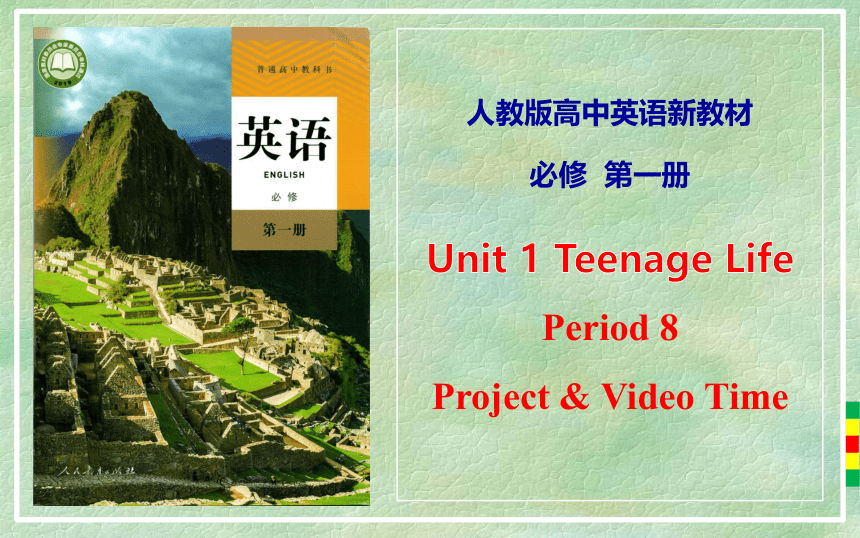 | |
| 格式 | pptx | ||
| 文件大小 | 775.0KB | ||
| 资源类型 | 教案 | ||
| 版本资源 | 人教版(2019) | ||
| 科目 | 英语 | ||
| 更新时间 | 2023-07-27 16:31:18 | ||
图片预览

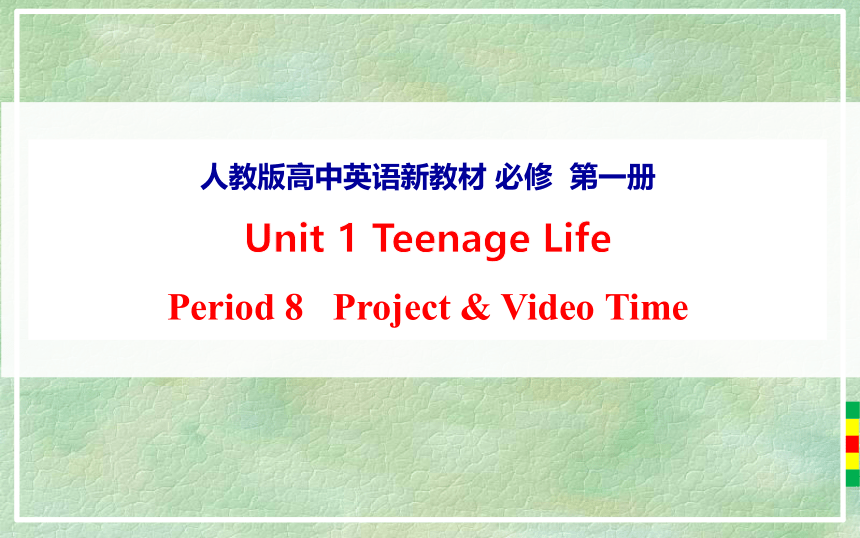
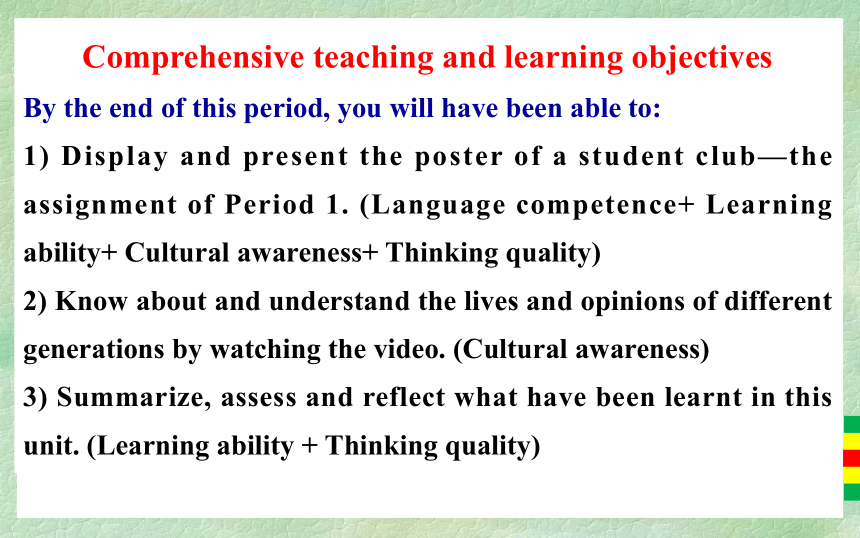
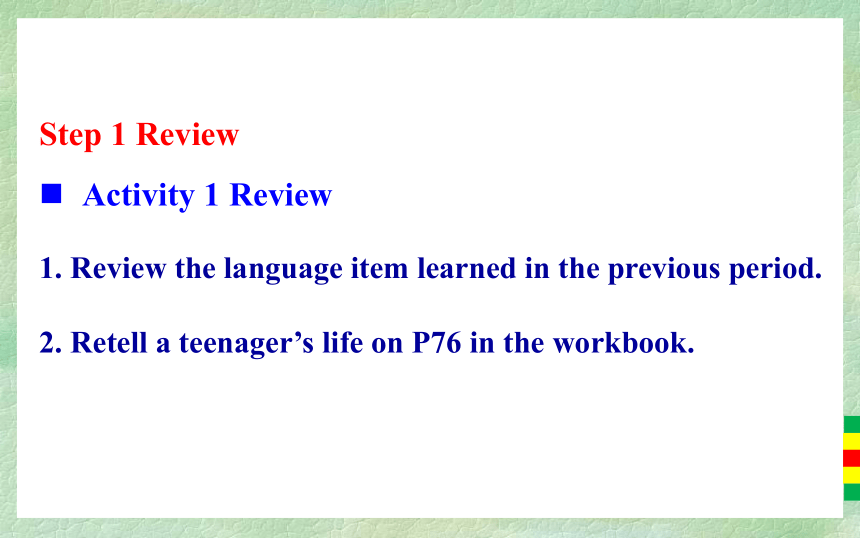
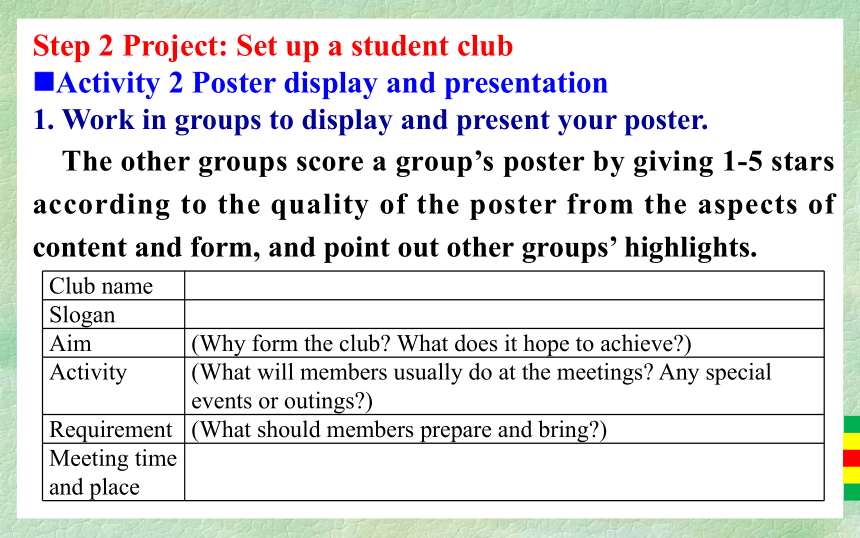
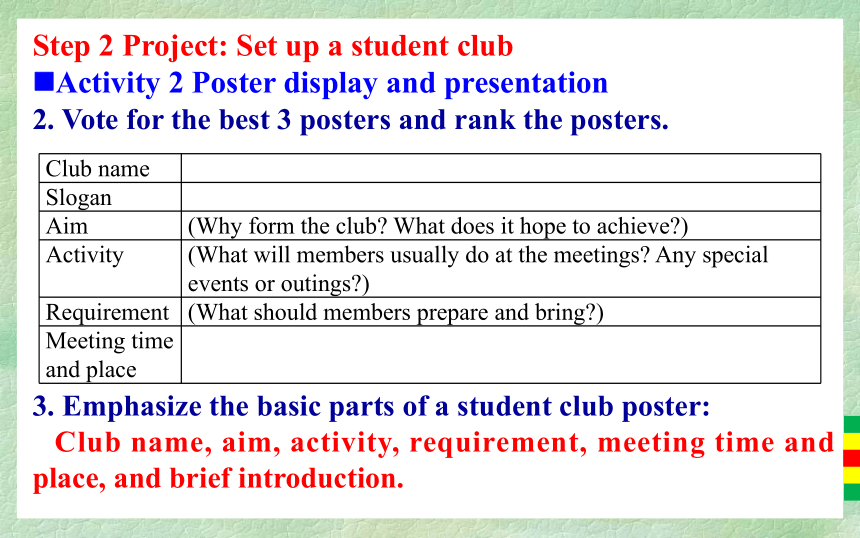

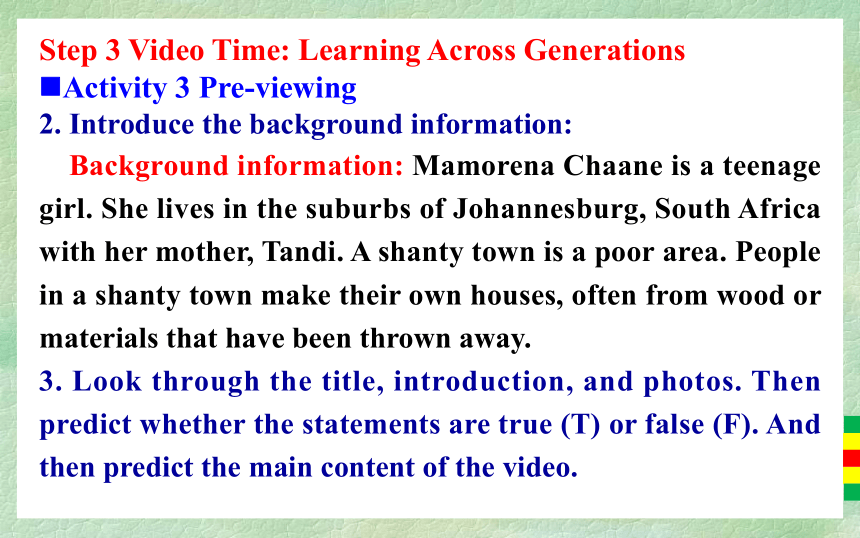
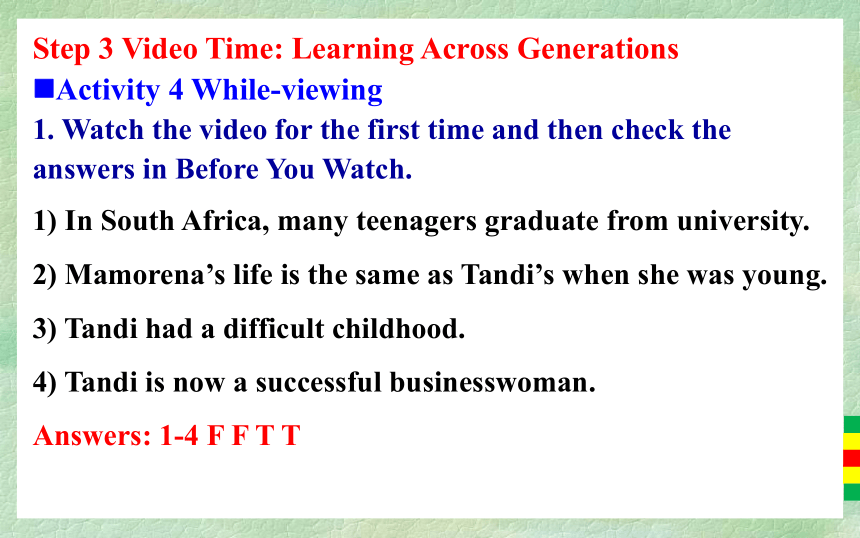
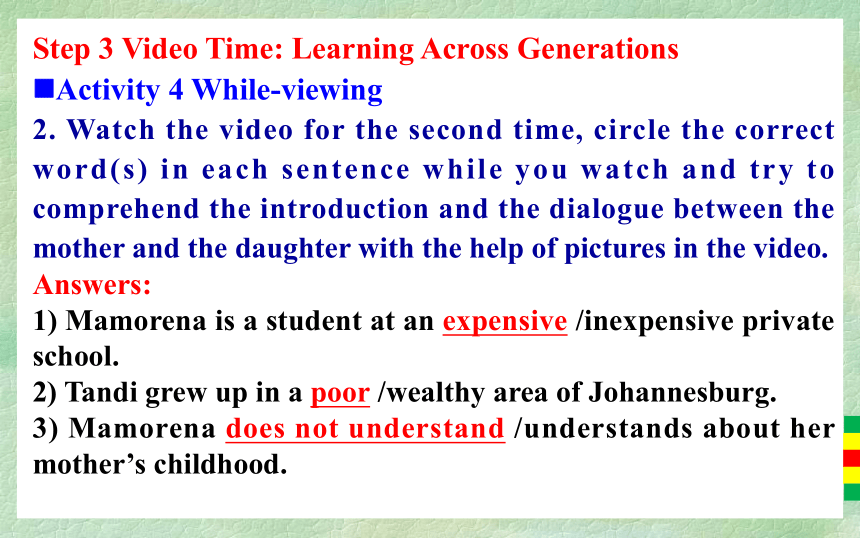
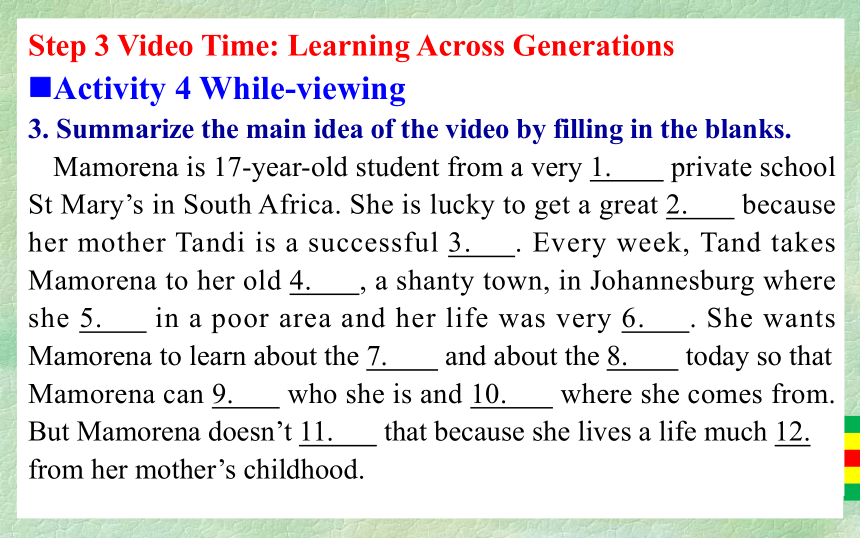
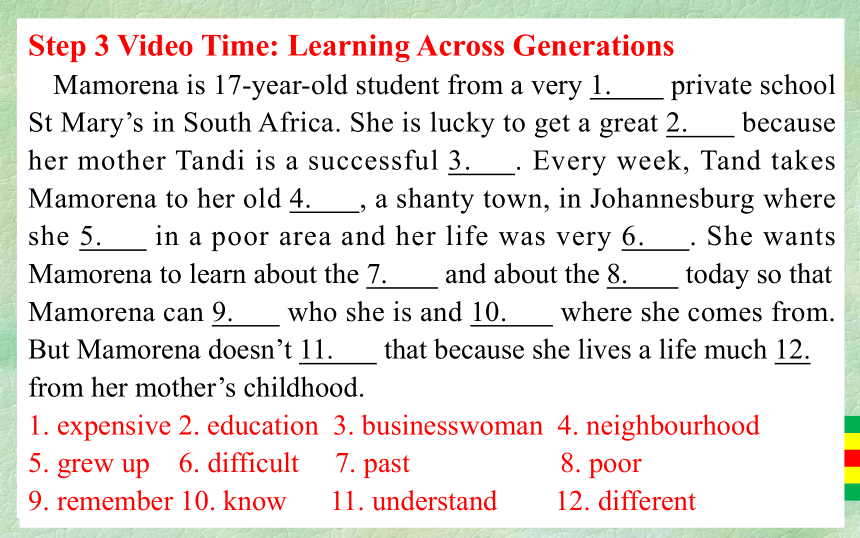
文档简介
(共34张PPT)
人教版高中英语新教材
必修 第一册
Unit 1 Teenage Life
Period 8
Project & Video Time
人教版高中英语新教材 必修 第一册
Unit 1 Teenage Life
Period 8 Project & Video Time
Comprehensive teaching and learning objectives
By the end of this period, you will have been able to:
1) Display and present the poster of a student club—the assignment of Period 1. (Language competence+ Learning ability+ Cultural awareness+ Thinking quality)
2) Know about and understand the lives and opinions of different generations by watching the video. (Cultural awareness)
3) Summarize, assess and reflect what have been learnt in this unit. (Learning ability + Thinking quality)
Step 1 Review
Activity 1 Review
1. Review the language item learned in the previous period.
2. Retell a teenager’s life on P76 in the workbook.
Step 2 Project: Set up a student club
Activity 2 Poster display and presentation
1. Work in groups to display and present your poster.
The other groups score a group’s poster by giving 1-5 stars according to the quality of the poster from the aspects of content and form, and point out other groups’ highlights.
Club name
Slogan
Aim (Why form the club What does it hope to achieve )
Activity (What will members usually do at the meetings Any special events or outings )
Requirement (What should members prepare and bring )
Meeting time and place
Step 2 Project: Set up a student club
Activity 2 Poster display and presentation
2. Vote for the best 3 posters and rank the posters.
3. Emphasize the basic parts of a student club poster:
Club name, aim, activity, requirement, meeting time and place, and brief introduction.
Club name
Slogan
Aim (Why form the club What does it hope to achieve )
Activity (What will members usually do at the meetings Any special events or outings )
Requirement (What should members prepare and bring )
Meeting time and place
Step 3 Video Time: Learning Across Generations
Activity 3 Pre-viewing
1. Lead in the topic by talking about generation gap, looking at the picture and predicting the content of the video.
Some clues (or questions):
1) Do you know generation gap What is it How do you feel about the generation gap between you and your parents
2) What can you see from the pictures What’s the possible relation between the two Where are they What are they doing
Step 3 Video Time: Learning Across Generations
Activity 3 Pre-viewing
2. Introduce the background information:
Background information: Mamorena Chaane is a teenage girl. She lives in the suburbs of Johannesburg, South Africa with her mother, Tandi. A shanty town is a poor area. People in a shanty town make their own houses, often from wood or materials that have been thrown away.
3. Look through the title, introduction, and photos. Then predict whether the statements are true (T) or false (F). And then predict the main content of the video.
Step 3 Video Time: Learning Across Generations
Activity 4 While-viewing
1. Watch the video for the first time and then check the answers in Before You Watch.
1) In South Africa, many teenagers graduate from university.
2) Mamorena’s life is the same as Tandi’s when she was young.
3) Tandi had a difficult childhood.
4) Tandi is now a successful businesswoman.
Answers: 1-4 F F T T
Step 3 Video Time: Learning Across Generations
Activity 4 While-viewing
2. Watch the video for the second time, circle the correct word(s) in each sentence while you watch and try to comprehend the introduction and the dialogue between the mother and the daughter with the help of pictures in the video.
Answers:
1) Mamorena is a student at an expensive /inexpensive private school.
2) Tandi grew up in a poor /wealthy area of Johannesburg.
3) Mamorena does not understand /understands about her mother’s childhood.
Step 3 Video Time: Learning Across Generations
Activity 4 While-viewing
3. Summarize the main idea of the video by filling in the blanks.
Mamorena is 17-year-old student from a very 1. private school St Mary’s in South Africa. She is lucky to get a great 2. because her mother Tandi is a successful 3. . Every week, Tand takes Mamorena to her old 4. , a shanty town, in Johannesburg where she 5. in a poor area and her life was very 6. . She wants Mamorena to learn about the 7. and about the 8. today so that Mamorena can 9. who she is and 10. where she comes from. But Mamorena doesn’t 11. that because she lives a life much 12. from her mother’s childhood.
Step 3 Video Time: Learning Across Generations
Mamorena is 17-year-old student from a very 1. private school St Mary’s in South Africa. She is lucky to get a great 2. because her mother Tandi is a successful 3. . Every week, Tand takes Mamorena to her old 4. , a shanty town, in Johannesburg where she 5. in a poor area and her life was very 6. . She wants Mamorena to learn about the 7. and about the 8. today so that Mamorena can 9. who she is and 10. where she comes from. But Mamorena doesn’t 11. that because she lives a life much 12. from her mother’s childhood.
1. expensive 2. education 3. businesswoman 4. neighbourhood
5. grew up 6. difficult 7. past 8. poor
9. remember 10. know 11. understand 12. different
Step 3 Video Time: Learning Across Generations
Activity 4 While-viewing
3. Summarize the main idea of the video by filling in the blanks.
Mamorena is 17-year-old student from a very expensive private school St Mary’s in South Africa. She is lucky to get a great education because her mother Tandi is a successful businesswoman. Every week, Tand takes Mamorena to her old neighbourhood, a shanty town, in Johannesburg where she grew up in a poor area and her life was very difficult. She wants Mamorena to learn about the past and about the poor today so that Mamorena can remember who she is and know where she comes from. But Mamorena doesn’t understand that because she lives a life much different from her mother’s childhood.
Step 3 Video Time: Learning Across Generations
Activity 5 Post-viewing
1. Work in pairs or groups to discuss the following questions.
1) Tandi said, “I don’t think you become a person if you don’t know where you come from.” Do you agree or disagree with this statement Why or why not
2) In what ways is your life similar to or different from your parents’ life when they were young
3) What can you learn from your own parents
2. Share your answers.
3. Question time.
Step 4 Evaluation and summary
Activity 6 Self-evaluation
Use the self-evaluation form to reflect your learning of this period.
Activity 7 Summary
Learning contents (What have you learned ) New skills
Text reconstruction 1
Text reconstruction 2
Learning effect (How is your learning ) Learning improvement (What will you do to improve your learning)
Step 4 Unit summary, assessment and reflection (2)
Activity 8 Revision and consolidation
Check the unit summary, assessment and reflection form your have completed to revise and consolidate the whole unit. And share your mind-maps.
Unit summary, assessment and reflection form
单元主题名称 Teenage Life(青少年生活)
单元主题语境 人与自我之学校学习和生活
语篇1 基本信息 所属板块:Opening page 语篇类型:多模态 (A Saying + a picture)
名称或主题:The saying “Good habits formed at youth make all the difference” by Aristotle.
语篇内容、结构与学习要素: What/how/why What (主题、内容): The importance of Good habits formed at youth.
How (结构、形式): It is a saying by Aristotle.
Why(目的、意图): It is to help us form the right life attitude.
语言学习要点 A phrase: make a difference
Step 4 Unit summary, assessment and reflection (2)
Activity 8 Revision and consolidation
Unit summary, assessment and reflection form
语篇思维导图
(语篇思维导图示例,其它部分语篇思维导图由学生自行完成)
Step 4 Unit summary, assessment and reflection (2)
Activity 8 Revision and consolidation
Unit summary, assessment and reflection form
语篇2 基本信息 所属板块:Listening and Speaking 语篇类型:口语对话/听说语篇
名称或主题:How to choose a school club
语篇内容、结构与学习要素: What/how/why What (主题、内容): Conversations about choosing a school club and giving reasons.
How (结构、形式): Conversations between two persons in audio form an oral form.
Why(目的、意图): To practice listening and speaking ability and arouse culture awareness.
Step 4 Unit summary, assessment and reflection (2)
Activity 8 Revision and consolidation
Unit summary, assessment and reflection form
语篇3 基本信息 所属板块:Reading and thinking 语篇类型:说明文/阅读语篇
名称或主题:The Freshman Challenge
语篇内容、结构与学习要素: What/how/why What (主题、内容): It mainly tells us the challenges Adam has to face as a freshman in senior high as well as some solutions and future plans.
How (结构、形式): It uses 3 supporting parts to explain the specific challenges Adam has to face and why Senior high school is really a big challenge.
Why(目的、意图): To practice reading comprehension, learn about teenager’s school life, new language items and develop language competence and thinking quality.
Step 4 Unit summary, assessment and reflection (2)
Activity 8 Revision and consolidation
Unit summary, assessment and reflection form
语言学习要点 Key words: ballet, volunteer, debate, prefer, content, movement, greenhouse, suitable, actually
Important phrases: prefer...to ...,clean up, suitable for,
Useful expressions:
Preference: I like/ love/ enjoy/ prefer…/I’m interested in…/I’m into…/I’m fond of…/I’m crazy about…/I don’t like…/I hate…/I have mixed feelings about…
Suggestion: I think you should…/Why not… / You can try…/Maybe you could…
语篇思维导图
Step 4 Unit summary, assessment and reflection (2)
Activity 8 Revision and consolidation
Unit summary, assessment and reflection form
语言学习要点 Key words: challenge, tittle, topic, confused, fluent, graduate, recommend, advance, literature, extra, obviously, quit, responsible, responsibility solution, schedule, editor
Important phrases: take courses, sign up (for sth), on my own, make the team, hand out, be responsible for, be well prepared
Important sentence patterns:
1. My adviser recommended that I should sign up for advanced literature because I like English and I’m good at it.
2. Obviously, I was unhappy, but I won’t quit.
3. I’ll find a way to improve on my own so that I can make the team next year.
4. Studying hard isn’t always fun, but I’ll be well prepared for university or whatever else comes in the future.
语篇思维导图
Step 4 Unit summary, assessment and reflection (2)
Activity 8 Revision and consolidation
Unit summary, assessment and reflection form
语篇4 基本信息 所属板块:Discovering Useful Structures 语篇类型:说明文/写作语篇
名称或主题:Cheerleader try-outs
语篇内容、结构与学习要素: What/how/why What (主题、内容): It presents the reasons why it was hard to be a cheerleader.
How (结构、形式): It uses the writer’s personal experiences to give explanations.
Why (目的、意图): To practice improving the passage by using noun/adjective/adverb phrases to add more information and know about teenager’s life after class.
语言学习要点 Grammar item: Knowing about the usage of noun/adjective/adverb phrases.
语篇思维导图和语法思维导图
Step 4 Unit summary, assessment and reflection (2)
Activity 8 Revision and consolidation
Unit summary, assessment and reflection form
语篇5 基本信息 所属板块:Listening and Talking 语篇类型:口语对话/听说语篇
名称或主题:Plan a camp for teenagers
语篇内容、结构与学习要素: What/how/why What (主题、内容): A conversation in which two students are taking about an adventure camp and an international youth camp and the future activities.
How (结构、形式): Conversations between two persons in audio form an oral form.
Why(目的、意图): To practice listening by using strategies to predict before listening and catching specific information to improve listening comprehension as well as speaking ability and arouse culture awareness.
Step 4 Unit summary, assessment and reflection (2)
Activity 8 Revision and consolidation
Unit summary, assessment and reflection form
语言学习要点 Key words: adventure, youth, survival, expert
Important phrases: make a fire, make some friends
Useful expressions (to talk about future activities): will do…/be (am/is/are) going to do…/plan/hope to do…/ There will be…
语篇思维导图
Step 4 Unit summary, assessment and reflection (2)
Activity 8 Revision and consolidation
Unit summary, assessment and reflection form
语篇6 基本信息 所属板块:Reading for writing 语篇类型:应用文(书信)/读写语篇
名称或主题:(Read and)Write a letter of advice
语篇内容、结构与学习要素: What/how/why What (主题、内容): A letter of advice—Susan Luo’s reply to teenagers asking for advice.
How (结构、形式): Learning about the form, organization and language features of a letter of advice by reading, and then learning to write a letter of advice according to the given situations.
Why(目的、意图): Making use of the input information and knowledge in reading to complete the writing task in the output writing process. And by the way, knowing about teenagers’ problems and thinking of some solutions.
Step 4 Unit summary, assessment and reflection (2)
Activity 8 Revision and consolidation
Unit summary, assessment and reflection form
语言学习要点 Key words: behaviour, generation, attract, focus, addict, adult
Important phrases: be attracted to, focus on, addicted to, concentrate on
Important sentence patterns:
1. It is not unusual for teenagers of your generation to be attracted to computer games and the online world.
2. But spending too much time online is unhealthy and makes it very difficult to focus on other things in life.
3. Some students even become addicted to the Internet and cannot concentrate on school and family life.
Step 4 Unit summary, assessment and reflection (2)
Activity 8 Revision and consolidation
Unit summary, assessment and reflection form
语篇7 基本信息 所属板块:Assessing Your progress 语篇类型:说明文/阅读语篇
名称或主题:Education in poor countries
语篇内容、结构与学习要素: What/how/why What (主题、内容): It describes the education in poor countries and encourages high school students to value their opportunities.
How (结构、形式): The usage of noun/adjective/adverb phrases.
Why(目的、意图): Consolidating the usage of noun/adjective/adverb phrases in reading passage.
Step 4 Unit summary, assessment and reflection (2)
Activity 8 Revision and consolidation
Unit summary, assessment and reflection form
语言学习要点 Useful expressions to express understanding and make suggestions:
1. Expressions to express understanding:
I understand quite well that…/I’m sorry to hear/know/learn that…/I know how it feels to…/I know you didn’t mean to…/It happens to everyone./ Everyone will have one of those periods when things seem to be going wrong.
2. Expressions to make suggestions:
I recommend that…/ I think you should…/ Why not… /I am sure…/You’d better…/Why don’t you… / How about… / I’d like to suggest…/What do you think… / My advice is / would be…/It might be a good idea to…
语篇思维导图
Step 4 Unit summary, assessment and reflection (2)
Activity 8 Revision and consolidation
Unit summary, assessment and reflection form
语篇8 基本信息 所属板块:Project 语篇类型:多模态语篇
名称或主题:Set up a student club and make a club poster.
语篇内容、结构与学习要素: What/how/why What (主题、内容): Project—Set up a student club and make a student club poster.
How (结构、形式): Knowing about how to make, display and present a student club poster.
Why(目的、意图): Using the language and culture knowledge learned in this unit.
语言学习要点 Basic parts of a student club poster: club name, aim, activity, requirement, meeting time and place, and brief introduction.
语篇思维导图
Step 4 Unit summary, assessment and reflection (2)
Activity 8 Revision and consolidation
Unit summary, assessment and reflection form
语言学习要点 Key words: prefer/like, generation/ teenager, schedule/plan
Important phrases: recommend sth. to sb, quit doing, be addicted to, be attracted to, focus on, make sb. confused
Important sentence patterns:
1. But did you know that 9 percent is also the number of children who are not at school
1. If you are one of the lucky ones who can go to a senior high school, you should be grateful for the opportunity.
2. So the next time you feel like you do not want to do boring, difficult homework or go to class, think about the children who don’t have the chance to get a good education.
3. Make the most of your education and make the world a better place.
语篇思维导图
Step 4 Unit summary, assessment and reflection (2)
Activity 8 Revision and consolidation
Unit summary, assessment and reflection form
语篇9 基本信息 所属板块:Video
语篇类型:视听语篇/口语对话多模态语篇
名称或主题:Learning Across Generations
语篇内容、结构与学习要素: What/how/why What (主题、内容): Different ideas and ways of life between two generations.
How (结构、形式): Video.
Why(目的、意图): Knowing about different ways of life around the world.
Step 4 Unit summary, assessment and reflection (2)
Activity 8 Revision and consolidation
Unit summary, assessment and reflection form
语言学习要点 Mamorena is 17-year-old student from a very expensive private school St Mary’s in South Africa. She is lucky to get a great education because her mother Tandi is a successful businesswoman. Every week, Tand takes Mamorena to her old neighbourhood, a shanty town, in Johannesburg where she grew up in a poor area and her life was very difficult. She wants Mamorena to learn about the past and about the poor today so that Mamorena can remember who she is and know where she comes from. But Mamorena doesn’t understand that because she lives a life much different from her mother’s childhood.
语篇思维导图
Step 4 Unit summary, assessment and reflection (2)
Activity 8 Revision and consolidation
Unit summary, assessment and reflection form
单元学习结果评价与反思
单元主题与语篇思维导图
Homework
1. Put what you have seen in the video into a story and add an end to it to write a complete story. (150-300 words)
2. Revise this unit.
人教版高中英语新教材
必修 第一册
Unit 1 Teenage Life
Period 8
Project & Video Time
人教版高中英语新教材 必修 第一册
Unit 1 Teenage Life
Period 8 Project & Video Time
Comprehensive teaching and learning objectives
By the end of this period, you will have been able to:
1) Display and present the poster of a student club—the assignment of Period 1. (Language competence+ Learning ability+ Cultural awareness+ Thinking quality)
2) Know about and understand the lives and opinions of different generations by watching the video. (Cultural awareness)
3) Summarize, assess and reflect what have been learnt in this unit. (Learning ability + Thinking quality)
Step 1 Review
Activity 1 Review
1. Review the language item learned in the previous period.
2. Retell a teenager’s life on P76 in the workbook.
Step 2 Project: Set up a student club
Activity 2 Poster display and presentation
1. Work in groups to display and present your poster.
The other groups score a group’s poster by giving 1-5 stars according to the quality of the poster from the aspects of content and form, and point out other groups’ highlights.
Club name
Slogan
Aim (Why form the club What does it hope to achieve )
Activity (What will members usually do at the meetings Any special events or outings )
Requirement (What should members prepare and bring )
Meeting time and place
Step 2 Project: Set up a student club
Activity 2 Poster display and presentation
2. Vote for the best 3 posters and rank the posters.
3. Emphasize the basic parts of a student club poster:
Club name, aim, activity, requirement, meeting time and place, and brief introduction.
Club name
Slogan
Aim (Why form the club What does it hope to achieve )
Activity (What will members usually do at the meetings Any special events or outings )
Requirement (What should members prepare and bring )
Meeting time and place
Step 3 Video Time: Learning Across Generations
Activity 3 Pre-viewing
1. Lead in the topic by talking about generation gap, looking at the picture and predicting the content of the video.
Some clues (or questions):
1) Do you know generation gap What is it How do you feel about the generation gap between you and your parents
2) What can you see from the pictures What’s the possible relation between the two Where are they What are they doing
Step 3 Video Time: Learning Across Generations
Activity 3 Pre-viewing
2. Introduce the background information:
Background information: Mamorena Chaane is a teenage girl. She lives in the suburbs of Johannesburg, South Africa with her mother, Tandi. A shanty town is a poor area. People in a shanty town make their own houses, often from wood or materials that have been thrown away.
3. Look through the title, introduction, and photos. Then predict whether the statements are true (T) or false (F). And then predict the main content of the video.
Step 3 Video Time: Learning Across Generations
Activity 4 While-viewing
1. Watch the video for the first time and then check the answers in Before You Watch.
1) In South Africa, many teenagers graduate from university.
2) Mamorena’s life is the same as Tandi’s when she was young.
3) Tandi had a difficult childhood.
4) Tandi is now a successful businesswoman.
Answers: 1-4 F F T T
Step 3 Video Time: Learning Across Generations
Activity 4 While-viewing
2. Watch the video for the second time, circle the correct word(s) in each sentence while you watch and try to comprehend the introduction and the dialogue between the mother and the daughter with the help of pictures in the video.
Answers:
1) Mamorena is a student at an expensive /inexpensive private school.
2) Tandi grew up in a poor /wealthy area of Johannesburg.
3) Mamorena does not understand /understands about her mother’s childhood.
Step 3 Video Time: Learning Across Generations
Activity 4 While-viewing
3. Summarize the main idea of the video by filling in the blanks.
Mamorena is 17-year-old student from a very 1. private school St Mary’s in South Africa. She is lucky to get a great 2. because her mother Tandi is a successful 3. . Every week, Tand takes Mamorena to her old 4. , a shanty town, in Johannesburg where she 5. in a poor area and her life was very 6. . She wants Mamorena to learn about the 7. and about the 8. today so that Mamorena can 9. who she is and 10. where she comes from. But Mamorena doesn’t 11. that because she lives a life much 12. from her mother’s childhood.
Step 3 Video Time: Learning Across Generations
Mamorena is 17-year-old student from a very 1. private school St Mary’s in South Africa. She is lucky to get a great 2. because her mother Tandi is a successful 3. . Every week, Tand takes Mamorena to her old 4. , a shanty town, in Johannesburg where she 5. in a poor area and her life was very 6. . She wants Mamorena to learn about the 7. and about the 8. today so that Mamorena can 9. who she is and 10. where she comes from. But Mamorena doesn’t 11. that because she lives a life much 12. from her mother’s childhood.
1. expensive 2. education 3. businesswoman 4. neighbourhood
5. grew up 6. difficult 7. past 8. poor
9. remember 10. know 11. understand 12. different
Step 3 Video Time: Learning Across Generations
Activity 4 While-viewing
3. Summarize the main idea of the video by filling in the blanks.
Mamorena is 17-year-old student from a very expensive private school St Mary’s in South Africa. She is lucky to get a great education because her mother Tandi is a successful businesswoman. Every week, Tand takes Mamorena to her old neighbourhood, a shanty town, in Johannesburg where she grew up in a poor area and her life was very difficult. She wants Mamorena to learn about the past and about the poor today so that Mamorena can remember who she is and know where she comes from. But Mamorena doesn’t understand that because she lives a life much different from her mother’s childhood.
Step 3 Video Time: Learning Across Generations
Activity 5 Post-viewing
1. Work in pairs or groups to discuss the following questions.
1) Tandi said, “I don’t think you become a person if you don’t know where you come from.” Do you agree or disagree with this statement Why or why not
2) In what ways is your life similar to or different from your parents’ life when they were young
3) What can you learn from your own parents
2. Share your answers.
3. Question time.
Step 4 Evaluation and summary
Activity 6 Self-evaluation
Use the self-evaluation form to reflect your learning of this period.
Activity 7 Summary
Learning contents (What have you learned ) New skills
Text reconstruction 1
Text reconstruction 2
Learning effect (How is your learning ) Learning improvement (What will you do to improve your learning)
Step 4 Unit summary, assessment and reflection (2)
Activity 8 Revision and consolidation
Check the unit summary, assessment and reflection form your have completed to revise and consolidate the whole unit. And share your mind-maps.
Unit summary, assessment and reflection form
单元主题名称 Teenage Life(青少年生活)
单元主题语境 人与自我之学校学习和生活
语篇1 基本信息 所属板块:Opening page 语篇类型:多模态 (A Saying + a picture)
名称或主题:The saying “Good habits formed at youth make all the difference” by Aristotle.
语篇内容、结构与学习要素: What/how/why What (主题、内容): The importance of Good habits formed at youth.
How (结构、形式): It is a saying by Aristotle.
Why(目的、意图): It is to help us form the right life attitude.
语言学习要点 A phrase: make a difference
Step 4 Unit summary, assessment and reflection (2)
Activity 8 Revision and consolidation
Unit summary, assessment and reflection form
语篇思维导图
(语篇思维导图示例,其它部分语篇思维导图由学生自行完成)
Step 4 Unit summary, assessment and reflection (2)
Activity 8 Revision and consolidation
Unit summary, assessment and reflection form
语篇2 基本信息 所属板块:Listening and Speaking 语篇类型:口语对话/听说语篇
名称或主题:How to choose a school club
语篇内容、结构与学习要素: What/how/why What (主题、内容): Conversations about choosing a school club and giving reasons.
How (结构、形式): Conversations between two persons in audio form an oral form.
Why(目的、意图): To practice listening and speaking ability and arouse culture awareness.
Step 4 Unit summary, assessment and reflection (2)
Activity 8 Revision and consolidation
Unit summary, assessment and reflection form
语篇3 基本信息 所属板块:Reading and thinking 语篇类型:说明文/阅读语篇
名称或主题:The Freshman Challenge
语篇内容、结构与学习要素: What/how/why What (主题、内容): It mainly tells us the challenges Adam has to face as a freshman in senior high as well as some solutions and future plans.
How (结构、形式): It uses 3 supporting parts to explain the specific challenges Adam has to face and why Senior high school is really a big challenge.
Why(目的、意图): To practice reading comprehension, learn about teenager’s school life, new language items and develop language competence and thinking quality.
Step 4 Unit summary, assessment and reflection (2)
Activity 8 Revision and consolidation
Unit summary, assessment and reflection form
语言学习要点 Key words: ballet, volunteer, debate, prefer, content, movement, greenhouse, suitable, actually
Important phrases: prefer...to ...,clean up, suitable for,
Useful expressions:
Preference: I like/ love/ enjoy/ prefer…/I’m interested in…/I’m into…/I’m fond of…/I’m crazy about…/I don’t like…/I hate…/I have mixed feelings about…
Suggestion: I think you should…/Why not… / You can try…/Maybe you could…
语篇思维导图
Step 4 Unit summary, assessment and reflection (2)
Activity 8 Revision and consolidation
Unit summary, assessment and reflection form
语言学习要点 Key words: challenge, tittle, topic, confused, fluent, graduate, recommend, advance, literature, extra, obviously, quit, responsible, responsibility solution, schedule, editor
Important phrases: take courses, sign up (for sth), on my own, make the team, hand out, be responsible for, be well prepared
Important sentence patterns:
1. My adviser recommended that I should sign up for advanced literature because I like English and I’m good at it.
2. Obviously, I was unhappy, but I won’t quit.
3. I’ll find a way to improve on my own so that I can make the team next year.
4. Studying hard isn’t always fun, but I’ll be well prepared for university or whatever else comes in the future.
语篇思维导图
Step 4 Unit summary, assessment and reflection (2)
Activity 8 Revision and consolidation
Unit summary, assessment and reflection form
语篇4 基本信息 所属板块:Discovering Useful Structures 语篇类型:说明文/写作语篇
名称或主题:Cheerleader try-outs
语篇内容、结构与学习要素: What/how/why What (主题、内容): It presents the reasons why it was hard to be a cheerleader.
How (结构、形式): It uses the writer’s personal experiences to give explanations.
Why (目的、意图): To practice improving the passage by using noun/adjective/adverb phrases to add more information and know about teenager’s life after class.
语言学习要点 Grammar item: Knowing about the usage of noun/adjective/adverb phrases.
语篇思维导图和语法思维导图
Step 4 Unit summary, assessment and reflection (2)
Activity 8 Revision and consolidation
Unit summary, assessment and reflection form
语篇5 基本信息 所属板块:Listening and Talking 语篇类型:口语对话/听说语篇
名称或主题:Plan a camp for teenagers
语篇内容、结构与学习要素: What/how/why What (主题、内容): A conversation in which two students are taking about an adventure camp and an international youth camp and the future activities.
How (结构、形式): Conversations between two persons in audio form an oral form.
Why(目的、意图): To practice listening by using strategies to predict before listening and catching specific information to improve listening comprehension as well as speaking ability and arouse culture awareness.
Step 4 Unit summary, assessment and reflection (2)
Activity 8 Revision and consolidation
Unit summary, assessment and reflection form
语言学习要点 Key words: adventure, youth, survival, expert
Important phrases: make a fire, make some friends
Useful expressions (to talk about future activities): will do…/be (am/is/are) going to do…/plan/hope to do…/ There will be…
语篇思维导图
Step 4 Unit summary, assessment and reflection (2)
Activity 8 Revision and consolidation
Unit summary, assessment and reflection form
语篇6 基本信息 所属板块:Reading for writing 语篇类型:应用文(书信)/读写语篇
名称或主题:(Read and)Write a letter of advice
语篇内容、结构与学习要素: What/how/why What (主题、内容): A letter of advice—Susan Luo’s reply to teenagers asking for advice.
How (结构、形式): Learning about the form, organization and language features of a letter of advice by reading, and then learning to write a letter of advice according to the given situations.
Why(目的、意图): Making use of the input information and knowledge in reading to complete the writing task in the output writing process. And by the way, knowing about teenagers’ problems and thinking of some solutions.
Step 4 Unit summary, assessment and reflection (2)
Activity 8 Revision and consolidation
Unit summary, assessment and reflection form
语言学习要点 Key words: behaviour, generation, attract, focus, addict, adult
Important phrases: be attracted to, focus on, addicted to, concentrate on
Important sentence patterns:
1. It is not unusual for teenagers of your generation to be attracted to computer games and the online world.
2. But spending too much time online is unhealthy and makes it very difficult to focus on other things in life.
3. Some students even become addicted to the Internet and cannot concentrate on school and family life.
Step 4 Unit summary, assessment and reflection (2)
Activity 8 Revision and consolidation
Unit summary, assessment and reflection form
语篇7 基本信息 所属板块:Assessing Your progress 语篇类型:说明文/阅读语篇
名称或主题:Education in poor countries
语篇内容、结构与学习要素: What/how/why What (主题、内容): It describes the education in poor countries and encourages high school students to value their opportunities.
How (结构、形式): The usage of noun/adjective/adverb phrases.
Why(目的、意图): Consolidating the usage of noun/adjective/adverb phrases in reading passage.
Step 4 Unit summary, assessment and reflection (2)
Activity 8 Revision and consolidation
Unit summary, assessment and reflection form
语言学习要点 Useful expressions to express understanding and make suggestions:
1. Expressions to express understanding:
I understand quite well that…/I’m sorry to hear/know/learn that…/I know how it feels to…/I know you didn’t mean to…/It happens to everyone./ Everyone will have one of those periods when things seem to be going wrong.
2. Expressions to make suggestions:
I recommend that…/ I think you should…/ Why not… /I am sure…/You’d better…/Why don’t you… / How about… / I’d like to suggest…/What do you think… / My advice is / would be…/It might be a good idea to…
语篇思维导图
Step 4 Unit summary, assessment and reflection (2)
Activity 8 Revision and consolidation
Unit summary, assessment and reflection form
语篇8 基本信息 所属板块:Project 语篇类型:多模态语篇
名称或主题:Set up a student club and make a club poster.
语篇内容、结构与学习要素: What/how/why What (主题、内容): Project—Set up a student club and make a student club poster.
How (结构、形式): Knowing about how to make, display and present a student club poster.
Why(目的、意图): Using the language and culture knowledge learned in this unit.
语言学习要点 Basic parts of a student club poster: club name, aim, activity, requirement, meeting time and place, and brief introduction.
语篇思维导图
Step 4 Unit summary, assessment and reflection (2)
Activity 8 Revision and consolidation
Unit summary, assessment and reflection form
语言学习要点 Key words: prefer/like, generation/ teenager, schedule/plan
Important phrases: recommend sth. to sb, quit doing, be addicted to, be attracted to, focus on, make sb. confused
Important sentence patterns:
1. But did you know that 9 percent is also the number of children who are not at school
1. If you are one of the lucky ones who can go to a senior high school, you should be grateful for the opportunity.
2. So the next time you feel like you do not want to do boring, difficult homework or go to class, think about the children who don’t have the chance to get a good education.
3. Make the most of your education and make the world a better place.
语篇思维导图
Step 4 Unit summary, assessment and reflection (2)
Activity 8 Revision and consolidation
Unit summary, assessment and reflection form
语篇9 基本信息 所属板块:Video
语篇类型:视听语篇/口语对话多模态语篇
名称或主题:Learning Across Generations
语篇内容、结构与学习要素: What/how/why What (主题、内容): Different ideas and ways of life between two generations.
How (结构、形式): Video.
Why(目的、意图): Knowing about different ways of life around the world.
Step 4 Unit summary, assessment and reflection (2)
Activity 8 Revision and consolidation
Unit summary, assessment and reflection form
语言学习要点 Mamorena is 17-year-old student from a very expensive private school St Mary’s in South Africa. She is lucky to get a great education because her mother Tandi is a successful businesswoman. Every week, Tand takes Mamorena to her old neighbourhood, a shanty town, in Johannesburg where she grew up in a poor area and her life was very difficult. She wants Mamorena to learn about the past and about the poor today so that Mamorena can remember who she is and know where she comes from. But Mamorena doesn’t understand that because she lives a life much different from her mother’s childhood.
语篇思维导图
Step 4 Unit summary, assessment and reflection (2)
Activity 8 Revision and consolidation
Unit summary, assessment and reflection form
单元学习结果评价与反思
单元主题与语篇思维导图
Homework
1. Put what you have seen in the video into a story and add an end to it to write a complete story. (150-300 words)
2. Revise this unit.
